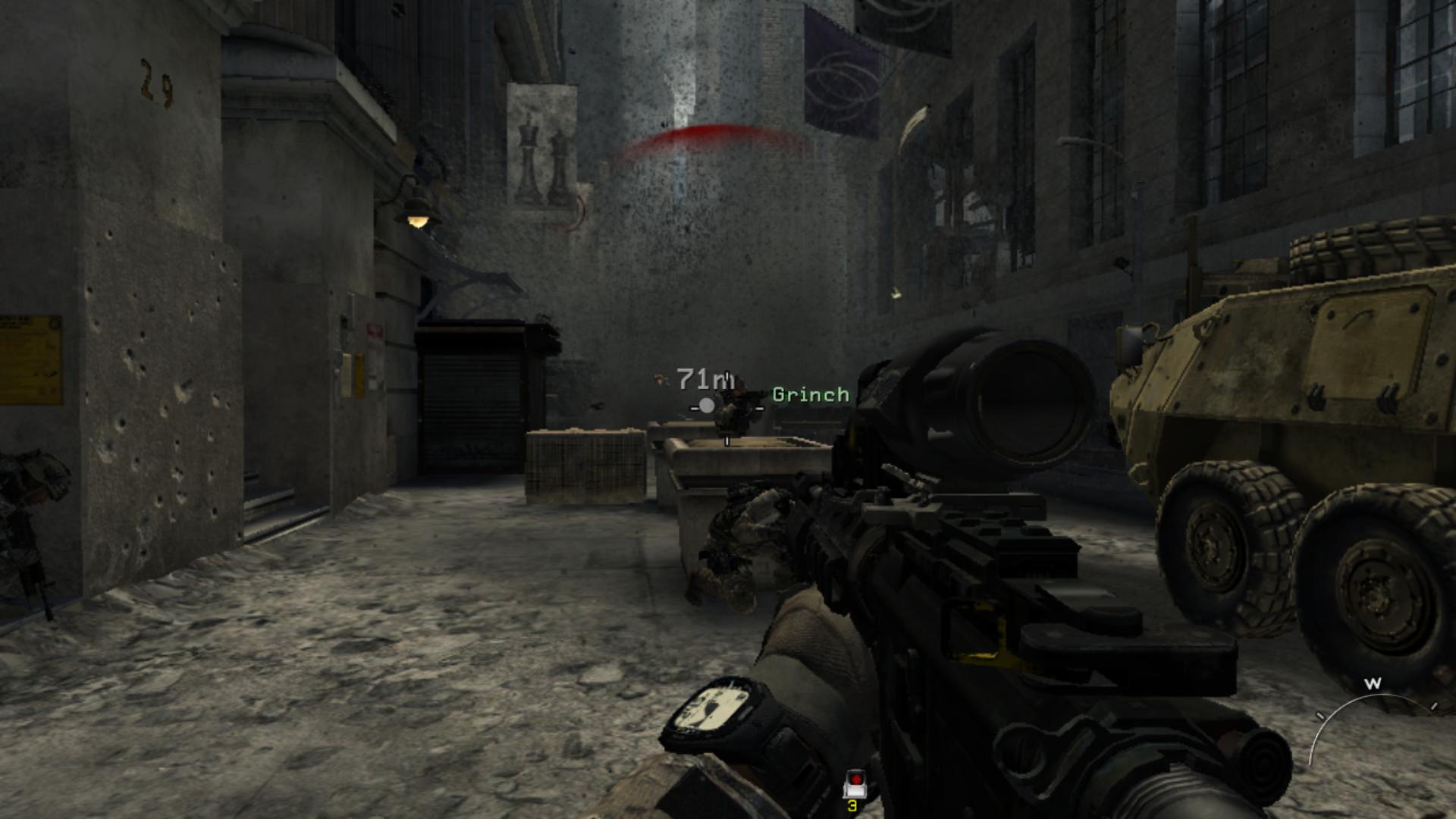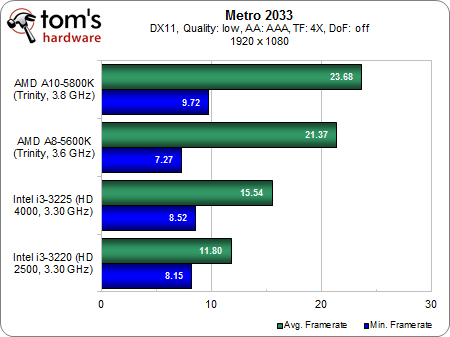Gaming At 1920x1080: AMD's Trinity Takes On Intel HD Graphics
Think you're pretty snazzy because your integrated graphics core plays mainstream games at 1280x720? We're on to bigger and better things, like modern titles at 1920x1080. Can AMD's Trinity architecture push high-enough frame rates to make this possible?
Benchmark Results: Call Of Duty: MW3 And Metro 2033
While console versions of Modern Warfare 3 remain far more popular than PC, keep in mind that the Xbox 360 edition plays at a significantly lower resolution.
Unless otherwise noted, we benchmarked our titles using Fraps, grabbing 60 seconds of action at the first playable level.
The good news here is obvious. All of our configurations are easily able to average more than 30 FPS. Even the humble Core i3-3220 sustains more than a 44 FPS minimum. Given the modest image quality settings, there's plenty of headroom to push better-looking detail settings or apply anti-aliasing. Call of Duty is a DirectX 9-based title famous for its lightweight engine.
Interestingly, while the Core i3-3225's average frame rate is 8.9% higher than the -3220's (we would have expected more, suggesting some sort of processor bottleneck), Fraps records a lower minimum frame rate. This could simply be a consequence of the suspected platform limitation and a brief hiccup, though.
Also notable is that the results from our two AMD chips are virtually identical. This is further proof of a processor bottleneck, since both APUs sport dissimilar graphics hardware, and really should be performing differently.
Metro 2033, one of the most demanding games we test, gives us some good news, but mostly bad.
The good news is that each of these processors now scales the way we'd expect. Metro's graphics workload is much better able to expose the various execution unit and shader configurations used by Intel and AMD.
Get Tom's Hardware's best news and in-depth reviews, straight to your inbox.
Unfortunately, even at the game's lowest-end DirectX 11 settings, none of our four chips come anywhere close to demonstrating playable performance at 1920x1080.
Current page: Benchmark Results: Call Of Duty: MW3 And Metro 2033
Prev Page Test Setup And Benchmarks Next Page Benchmark Results: Skyrim And Deus Ex: HR-
azathoth Seems like a perfect combination for a Casual PC gamer, I'm just curious as to the price of the Trinity APU's.Reply -
luciferano They both have graphics that have HD in their name, but AMD's HD graphics are more *HD*, lol.Reply -
Nintendo Maniac 64 Err... did we really need both the A10-5800k and the A8-5600k? Seeing how both are already 100w unlocked CPUs, surely something like an A10-5800k vs a 65w A10-5700 would have been more interesting for an HTPC environment...Reply -
mayankleoboy1 Consoles set the bar for game developers. These iGPU's are comparable to the consoles and thats why games will run smooth here.Reply
With next gen consoles coming out next year, game devs will target them. Hence the minimum standard for games will rise, making the next gen games much slower on the iGPU's. So both AMD and Intel will have to increase performance much more in the next 1-2 years.
tl;dr : next gen games will run poorly on these igpu's as next gen consoles will set the minimum performance standard. -
mousseng Reply
Keep in mind, though, that that's exactly what's going to allow AMD and Intel to advance their hardware faster than games will, as they were discussing in the article (first page of the interview). Look how far Fusion and HD Graphics have come over the past 3 years, and look how long the previous console generation lasted - if that trend is anything to go by, I'm sure integrated graphics could easily become a viable budget gaming option in the next few years.9537609 said:tl;dr : next gen games will run poorly on these igpu's as next gen consoles will set the minimum performance standard. -
falchard Since when as AMD or nVidia actually taken on Intel graphics? Thats a bit insulting considering the disproportionate results time and time again.Reply -
luciferano mayankleoboy1Consoles set the bar for game developers. These iGPU's are comparable to the consoles and thats why games will run smooth here.With next gen consoles coming out next year, game devs will target them. Hence the minimum standard for games will rise, making the next gen games much slower on the iGPU's. So both AMD and Intel will have to increase performance much more in the next 1-2 years.tl;dr : next gen games will run poorly on these igpu's as next gen consoles will set the minimum performance standard.Reply
Actually, the A10 and A8 have somewhat superior graphics compared to current consoles. Current consoles can't even play in 720p as well as these AMD IGPs played 1080p despite being a more optimized platform, so that this is true is kinda obvious IMO. Also, new games would simply mean dropping resolution for these APUs. They wouldn't be unable to play new games, just probably at 1080p and 16xx by 900/10xx resolutions too.
Intel probably isn't very motivated by gaming performance for their IGPs and they're supposedly making roughly 100% performance gains per generation with their top-end IGPs anyway, so they're working on growing IGP performance. AMD also gets to use GCN in their next APU and I don't think that I need to explain the implications there, especially if they go the extra mile with using their high-density library tech too.



